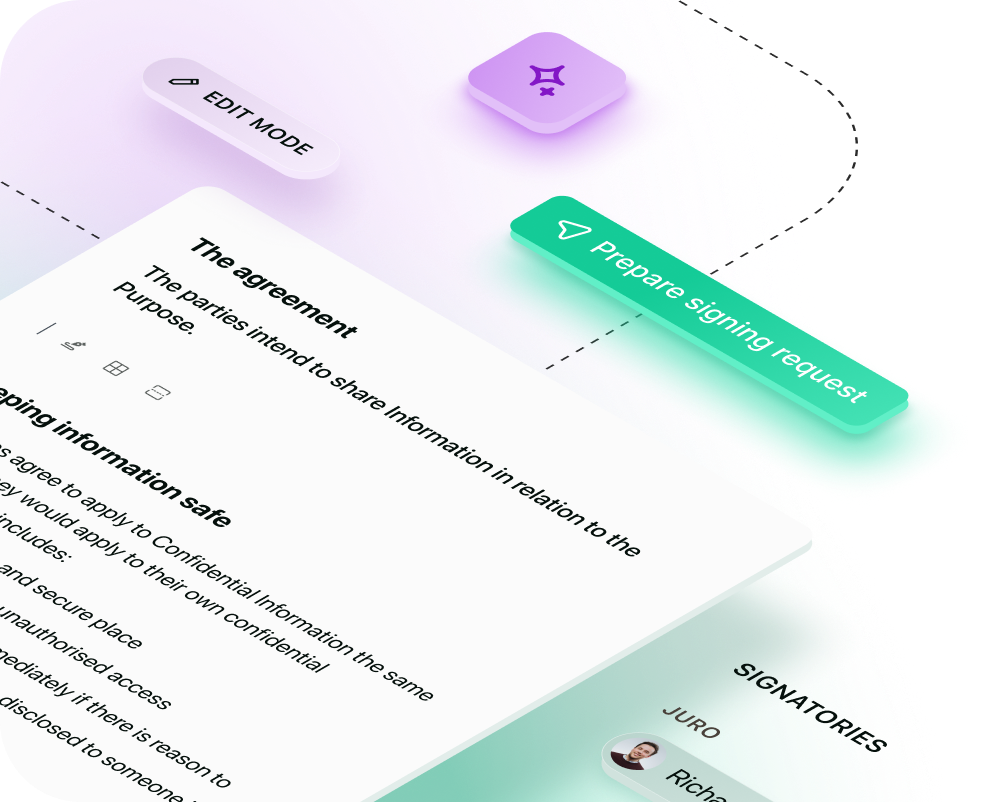Solutions
Customer Support
Resources
Looking for a rent to own agreement template? Download this free version today.




Rent to own agreements offer flexibility and benefits for both tenants and landlords. They allow tenants to rent a property with the option to buy it later, often with part of the rent paid contributing towards the purchase price.
This article explores the details of rent to own agreements, their purposes, management, usage, and what should be included in a template. We will also look at how Juro can automate these agreements, making the process smoother for businesses.
A rent to own agreement is a legal contract between a landlord and a tenant. It allows the tenant to rent a property for a specified period with the option to purchase the property at the end of the lease term. This type of agreement combines elements of both a lease agreement and a purchase agreement.

The primary purpose of a rent to own agreement is to provide a pathway to homeownership for tenants who may not yet be able to purchase a property outright.
Management of rent to own agreements typically involves various stakeholders. These include landlords or property managers, who are responsible for drafting the agreement, collecting payments, and handling property maintenance. They also manage the logistics of the potential sale if the tenant decides to buy the property.
Tenants are responsible for making rental payments, maintaining the property according to the agreement, and deciding whether to exercise the purchase option, while lawyers or real estate agents may assist in drafting the agreement to ensure it complies with local laws and protects both parties. They can also provide advice and support during negotiations and potential disputes.

Rent to own agreements are commonly used in the following scenarios:
A comprehensive rent to own agreement template should cover the following sections:

Managing rent to own agreements manually involves several steps:
1. Drafting the agreement: Creating the document from scratch or using a template, ensuring all necessary clauses are included. This often requires legal expertise to avoid omissions or errors.
2. Customizing for each transaction: Adjusting terms and conditions based on the specific needs and circumstances of each agreement. This can be time-consuming and prone to inconsistencies.
3. Review and approval: Having legal professionals review the contract for compliance and accuracy, which adds another layer of cost and time.
4. Execution: Both parties sign the agreement, often requiring physical presence or coordination for signatures. This step can be cumbersome, especially when dealing with multiple agreements.
5. Storage and tracking: Keeping physical or digital copies of the agreement, tracking payment schedules, and maintaining communication between parties. This can lead to disorganization and lost documents if not managed properly.
While the manual approach can be effective, it is time-consuming and prone to errors, especially for businesses handling a high volume of agreements.
Fortunately. automating rent to own agreements with Juro’s contract management software offers several benefits. Here’s how Juro can streamline the process:
Juro allows teams to generate, review, and approve rent to own agreements without constant legal intervention. This self-serve approach enables non-legal teams to handle standard agreements, freeing up legal departments to focus on more complex matters. By using Juro’s intuitive interface, employees can easily create agreements based on pre-approved templates, ensuring consistency and compliance.

Juro’s platform supports real-time collaboration, allowing multiple stakeholders to input and approve agreements seamlessly. This feature reduces bottlenecks, accelerates the contract lifecycle, and ensures that all parties are on the same page. Teams can comment, suggest edits, and approve documents all within the same platform, reducing the need for back-and-forth emails and ensuring that everyone is working with the most up-to-date version of the contract.
By leveraging generative AI, Juro can assist you in drafting rent to own agreements quickly and accurately. AI tools help identify risks, ensure compliance, and provide negotiation insights, leading to faster, more informed decision-making and reduced legal risk. The AI can suggest clause improvements, flag potential issues, and even assist in the negotiation process by providing data-driven insights, making the entire process more efficient and reliable.
Juro provides a single, secure repository for all contracts, offering comprehensive visibility into the status, deadlines, and obligations of each agreement. This centralized storage simplifies retrieval and auditing, ensuring that no contract is ever lost or overlooked. Users can easily search for and access contracts, monitor key dates, and receive notifications for upcoming deadlines, ensuring that all contractual obligations are met on time.
Juro integrates seamlessly with existing tools such as CRM and project management software. This integration ensures that contract management fits naturally into your business processes, minimizing disruption and improving efficiency. By connecting Juro with the tools your teams already use, you can streamline workflows, reduce manual data entry, and ensure that contract data is always up-to-date and accessible across different platforms.
Juro’s analytics tools provide real-time insights into contract performance and risk. By analyzing contract data, businesses can make informed decisions, identify trends, and address potential issues proactively. The platform offers detailed reports and dashboards that help you track key metrics such as contract cycle times, approval bottlenecks, and compliance rates, enabling you to continuously improve your contract management processes.
Juro’s AI-native contract automation platform empowers all teams to create, agree, execute and manage contracts up to 10x faster than traditional tools. To find out more, hit the button below to book your personalized demo.
Juro is the #1-rated contract platform globally for speed of implementation.


Juro embeds contracting in the tools business teams use every day, so they can agree and manage contracts end-to-end - while legal stays in control.
Book your demo